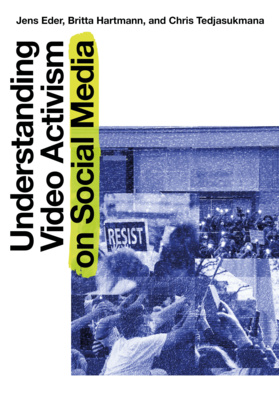Understanding Video Activism on Social Media (Book)
What political power do videos have on social media? And how can democratic activists on the Internet assert themselves against propaganda, disinformation and the entertainment industry? Understanding video activism is becoming ever more important at a time when moving images on platforms are increasingly influencing political processes. 22 illus.
A PDF version of this book is available for free in Open Access: Understanding Video Activism on Social Media. It has been made available under a Creative Commons Attribution 4.0 International Public License.
Edition
What political power do videos on social media have? In what ways do they exert influence, shape publics and change political life? And how can committed civil society actors in this field assert themselves against hegemonic discourses, commercial interests, anti-democratic agitation, and authoritarian propaganda? These questions are being debated intensely as social media increasingly dominate global information flows, and videos increasingly dominate social media.
Understanding video activism seems particularly relevant at a time when the internet is undergoing fundamental disruptions. The forms, practices, and opportunities of activism depend on its media environment, which now is changing rapidly and profoundly in terms of its technological basis, ownership, legal regulations, and governmental control.
Jens Eder teaches media studies, aesthetics and narrative theory at the Filmuniversität Babelsberg KONRAD WOLF, Potsdam, Germany. His research focuses on contemporary audiovisual media, their forms, effects and relations to society.
Britta Hartmann teaches film studies and audiovisual media cultures at the University of Bonn, Germany. Her research focuses on film theory and aesthetics, documentary history and practice. She is one of the founding editors of the journal Montage AV.
Chris Tedjasukmana is Professor of Everyday Media and Digital Cultures at the Johannes Gutenberg University of Mainz, Germany. His current research focuses on media practices of witnessing, critical phenomenologies of media bodies, and political film aesthetics.
List of Figures
Acknowledgments
Introduction: The Power of Video Activism
1. The Media Logics of Video Activism: Frames, Forms, and Platforms
Political Contexts and Frames of Video Activism
Common Forms and Types of Activist Videos
The System of Social Media Platforms
The Platform System in the Age of the Splinternet
How to Outsmart Platforms: The Most Boring Viral Video
2. Trajectories of Video Activism: Past and Present
Demanding Representation, Criticizing Capitalism
Participation and a Voice of One’s Own
Political Aesthetics
The Role of Media Technology in the History of Video Activism
Videos Everywhere: Between Empowerment and Disillusionment
3. The Impact of Political Videos: Attention, Affect, Action
Pathways to Impact
Competing for Attention, Overcoming Obstacles
Image Wars in the Discourse on Migration
Political Emotions and the Different Audiences of Activism
4. Activist Video Strategies: From Creation to Networking
Video Aesthetics and Spreadability: A Variety of Effective Forms
The Dynamics of Distribution: Networked Attention and Emergent Narratives
General Video Strategies in the Climate Crisis Discourse
A Case of Strategic Provocation: Rezo’s “Destruction of the CDU”
5. The Diversity of Video Activists: Practices and Communities
Small Media Collectives: Committed and Counterpublic
Influencer Networks: Hybrid and Hypervisible
Large NGOs: Established and Evolving
Hashtag Movements: Polyphonic and Unpredictable
Embracing the Diversity of Video Activism
6. Video Activism and the Public Sphere: Creating Counterpublics
Publics and Counterpublics
Creating Counterpublics: The Case of Black Lives Matter
Expanding the Democratic Public Sphere
7. Video Activism in Times of Upheaval: Toward Diversity in Solidarity
Video Activism at War: Changing Contexts, Shifting Roles
Video Activism Under Pressure
A Plea for Diversity in Solidarity
Notes
Media References
Bibliography
'If you want to understand the power of video activism not just as a political tool but as a social force, please read this book. The authors manage to analyze in depth the historical, rhetorical, aesthetical, and other aspects of video activism and how it is enmeshed in the distribution logic of social media. Due to its geopolitical scope combined with a broad analytical framework, Understanding Video Activism on Social Media is an eye-opener for students, scholars, and activists alike.'
'This rich analysis of video activism shows how activists use video production and platform technologies to create often impressive public engagement for their causes. The authors examine an intriguing variety of cases that reveal the challenges and opportunities facing movements in increasingly noisy communication environments. In addition, the book places video activism in the larger contests of platforms, power, and geopolitics. Students of social movements, democracy, and media will find this a valuable resource that changes how we think about activist communication.'
'This book offers a thorough and engaging review of the changing contexts, practices and forms of video activism. It is alert to shifts in technology and aesthetics as well as to changing modes of access and engagement, framing these within broader political and economic factors. Clear and provocative, it will refresh and stimulate the debate about what media 'activism' now means and what it could mean in the settings of both vigorous platform capitalism and increasing tendencies to authoritarian restriction.'
'This book offers valuable insights into the evolving role of video in activism. The authors discuss video activism across various time periods and media forms, from documentary films to TikTok videos. They provide a unique perspective on the continuity and specificities in how videos are deployed to champion causes and mobilize collective action. By incorporating relevant concepts and theories, the authors enrich the discussion with a strong analytical framework. Rich with both historical and contemporary case examples, this book will be a useful resource for media communication scholars and students.'














